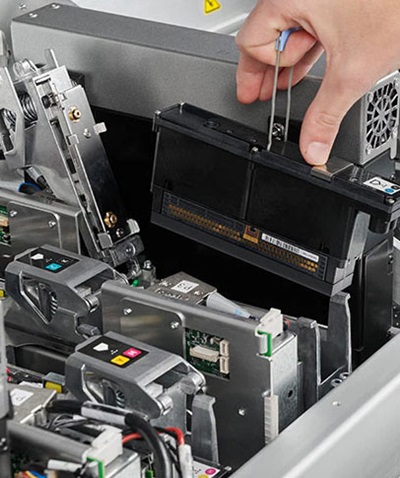
Accelerating Time to Market with Improved Processes and Production with Windchill
HP is a leading global provider of software, technologies, and products with a rich history and tradition in manufacturing. Headquartered in Palo Alto, California, HP offers information and technology services as well as manufacturing PCs, printers, and computer accessories. The leadership team decided to expand its portfolio of solutions and implemented a Large Format Printing (LFP) and 3D printing segment. Its LFP and Digital Manufacturing division started designing and assembling printers for multiple industries ranging from aerospace to consumer goods. HP is fairly new in LFP and 3D printing, but it has high expectations for disrupting the industry.
LFP provides valuable solutions that enable HP’s customers to enter new markets, streamline processes, and improve offerings through customization and new levels of productivity. HP has poured a lot of resources into its LFP operations. Multiple locations around the world support HP’s wide range of printing solutions. The design department is located in Barcelona, Spain and the manufacturing facilities are located in Southeast Asia: China, Singapore, and Malaysia. The manufacturer produces around 30 different models, based on seven different platforms that can have hundreds of SKUs. And 400 out of their 600 engineers are currently focused on LPF and 3D printing. With so much going on, HP’s printing products and manufacturing processes were getting increasingly complex.
Originally, HP’s engineering systems were developed to manufacture simple printers with a stable and small number of changes manufactured locally. Now they build and manage larger, more elaborate printers with thousands of parts. This expansion in the product portfolio has increased complexity in manufacturing and change management.
Challenges of developing new products
 There wasn’t a standardized product data management
system (PDM) in place to support HP’s new product
development (NPD) processes. Additionally, its LFP
products contain several thousand parts compared to
200 to 400 parts in the original printers.
There wasn’t a standardized product data management
system (PDM) in place to support HP’s new product
development (NPD) processes. Additionally, its LFP
products contain several thousand parts compared to
200 to 400 parts in the original printers.
HP designers were managing more drawings and making changes more frequently. At the beginning of manufacturing LFP printers, the hundreds of changes that took place daily were entered manually, which left a lot of room for error. This process only had a generic engineering bill of materials (EBOM) in place. For instance, a new product can go through as many as one thousand changes in the design phase — depending on whether engineers are modifying an existing design or making a new one. Once a product is in the development phase, changes can occur daily.
The manufacturing and supply chain that supports HP is global. However, data was siloed across engineering, manufacturing, and service teams who handled processes manually or through paper. This process led to several challenges:
- Information handovers took place via email and other manual processes because of siloed data
- There was a disconnect between the supply chain and manufacturing sites in Asia and the design factory in Barcelona
- There was cost and quality pressure because of lack of governance
- Manufacturing teams weren’t able to capture changes quickly due to lack of access to CAD data
- HP had more programs and shorter time to market
- Inefficient supply chain and vendor collaboration
- They were lacking good manufacturing infrastructure
HP had several reasons to optimize its manufacturing processes. Leadership decided to implement a product life cycle management (PLM) solution to increase efficiency and better manage product information; reduce human error and improve quality by standardizing and digitizing processes and data management; and integrate product information into a single repository through a product-based digital thread.
PTC’s Windchill helps HP optimize processes and manage complexity
In 2019 HP partnered with Integral Innovation Experts to begin their digital adoption strategy. Together, they decided Windchill was the best solution for the initiative. Windchill would enable HP to standardize and integrate processes, manage product design and manufacturing data more efficiently, and be more agile when responding to changes in the market.
What makes Windchill a powerful PLM solution is its data governance and traceability and its ability to provide out-of-the-box functionality to realize value quickly through standardized processes. Also, it delivers the core PDM, configuration and change management, and BOM management capabilities that streamline the sharing of reliable data anytime, anywhere.
HP and Integral Innovation Experts were impressed with Windchill’s accessibility and ease of use for experts and non-experts alike. Also, its open architecture enables seamless integration to manage, associate, orchestrate, and deliver data across the value chain.
Speeding the delivery of large format printing technology
Now Windchill provides HP with a single source of truth, which brings agility, scalability, and global collaboration. Also, it has improved the way users create, access, and manage product data across departments, eliminating unnecessary manual tasks. Implementing a variety of use cases has also enabled HP to have a significant impact across new product development (NPD).
"Working without Windchill was
challenging, and we needed to move
to a PLM system. We already had the
tool in place, so it was quick and easy
for us to get started."
David Pou, Program Manager, HP
Integral Innovation Experts is headquartered in Spain and has extensive experience providing PTC software solutions, training, expert support, and tailored services across the PTC product range.
With their agility and expertise, Integral Innovation Experts optimized HP’s digital journey and provided them with a clear competitive advantage.
“I’m in love with everything about this initiative: Windchill, Integral, PTC. I can’t imagine doing this transition without their partnership,” says David Pou, Program Manager at HP.
HP was able to unify their engineering tools and establish governance and traceability through one common system for product data management. The technology leader increased efficiency and reduced costs by removing manual work, handovers, and improving re-usability. Also, cross-functional interaction between engineers in early phases minimizes costly design changes later in the process.
Windchill enables a full operational bill of process across the enterprise and helps reduce the cost of human errors, accelerating the time to industrialization. The increased interactions between designers and manufacturing engineers during development helps HP identify issues early on and ensure manufacturability and agility.
"Windchill helps us achieve a higher
level of maturity and better integration
of electrical and mechanical designs
—leading to greater overall quality,"
Manuel Lopez, 3D Operations Program Manager, HP
HP can now create, collect, and control all change management requests in one system. Connectivity between parts in the engineering bill of materials (EBOMs), the manufacturing bills of material (MBOMs), and service bills of material (SBOMs), allows engineers to see the direct impact on downstream processes. They execute analysis on a single source of information, greatly reducing change cycle times. One single configurator makes it easier to connect options to a product and track its combinations.
Enhancing collaboration and effectively managing risks
Having consistent data and a single authoritative source of truth means that cross-functional teams can collaborate in one shared system and achieve improved product and process quality as well as reusability of assets. Suppliers manage their own BOMs and receive notifications of any changes through Windchill. In the future, supply chains will have access to designs to further improve communications between HP, suppliers, and vendors.
HP is currently conducting risk and reliability analysis with Windchill, leveraging failure mode and effect analysis (FMEA) capabilities. Moving forward, HP plans to implement Windchill’s CAPA capabilities to manage corrective and preventative actions. The CAPA workflow will allow HP to initiate, evaluate, assign, monitor, review, and approve corrective actions in a formal manner.
Streamlining HP’s industrialization processes
The transformation into digital engineering has helped HP manage complexity, decrease development costs, and improve speed to market—all while confidently relying on a single source of truth. HP has automated and implemented clear workflows to manage production information and improve communication. Similarly, they’ve significantly reduced the time it takes them to manage BOMs between design and manufacturing.
The manufacturer was able to save nine weeks of development time per program (programs typically take about two years in total). Also, HP improved BOM change turnaround time from one week to less than a day and eliminated 95% of BOM errors. Quality was improved by standardizing and digitizing process and data management. Furthermore, there was a great reduction in re-releases and 75% reduction in HP’s time to release.
HP aims to be the most sustainable and unbiased technology company
 HP has a 2030 Sustainability Impact Vision to become
the world’s most sustainable and unbiased technology
company. This vision is based on three pillars which
are planet, people, and community. For example,
its planet pillar is focused on climate action and
achieving net zero greenhouse gas (GHG) emissions
across the HP value chain. The next goal is to reach
75% product recyclability and reduce by 50% value
chain GHG emissions by 2030. Additionally, HP is trying
to accomplish carbon neutrality and zero waste in
HP operations.
HP has a 2030 Sustainability Impact Vision to become
the world’s most sustainable and unbiased technology
company. This vision is based on three pillars which
are planet, people, and community. For example,
its planet pillar is focused on climate action and
achieving net zero greenhouse gas (GHG) emissions
across the HP value chain. The next goal is to reach
75% product recyclability and reduce by 50% value
chain GHG emissions by 2030. Additionally, HP is trying
to accomplish carbon neutrality and zero waste in
HP operations.
The technology leader is focusing its sustainability strategies on product recyclability and reusability. The goal is to reduce materials, keep materials in use longer, and minimize deforestation. To track year over year progress against its defined targets, HP collects information from its products, services and supply chain regarding materials intensity, product usage (energy, paper, waste), repairs, and more.
While today, its Large Format Printing sustainability group is collecting most of the information very manually in Excel spreadsheets, HP plans to collect all this information in Windchill (material type, % of recycled content, weight, etc..) so that it can have everything together in one database and be able to prepare better dashboards and analyze the data easily at portfolio level to make better decisions.
Looking forward to an efficient PLM future
In addition to addressing sustainability, HP is looking forward to adding new capabilities and leveraging more value. Over the next year, it plans to extend all its current use cases and capabilities beyond NPD and into current products. HP’s next steps include: utilizing parts classification in Windchill, improving supplier management, incorporating ECAD, and taking advantage of MPM Link capabilities in Windchill to create process plans and work instructions. Also, HP is looking to complete its Windchill implementation in its 3D printing segment to be even more connected.
"Choose a partner who understands your business so there are no gaps between
the software implementation and your processes."
Manuel Lopez and David Pou, HP